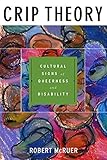Crip Theory : Cultural Signs of Queerness and Disability / Robert McRuer.
Material type: TextSeries: Cultural Front ; 9Publisher: New York, NY : New York University Press, [2006]Copyright date: ©2006Description: 1 online resourceContent type:
TextSeries: Cultural Front ; 9Publisher: New York, NY : New York University Press, [2006]Copyright date: ©2006Description: 1 online resourceContent type: - 9780814757123
- 9780814759868
- Culture
- Heterosexuality -- Social aspects
- Homosexuality -- Social aspects
- Marginality, Social
- Queer theory
- Sociology of disability
- SOCIAL SCIENCE / LGBT Studies / Gay Studies
- Both
- Crip
- Theory
- abject
- analyze
- bodies
- book
- centrally
- concerned
- disability
- each
- fields
- first
- identities
- inform
- interdisciplinary
- normal
- other
- pleasures
- queer
- represented
- studies
- these
- thoroughly
- ways
- which
- with
- 306.76/601 22
- HV1568 .M37 2006eb
- online - DeGruyter
| Item type | Current library | Call number | URL | Status | Notes | Barcode | |
|---|---|---|---|---|---|---|---|
 eBook
eBook
|
Biblioteca "Angelicum" Pont. Univ. S.Tommaso d'Aquino Nuvola online | online - DeGruyter (Browse shelf(Opens below)) | Online access | Not for loan (Accesso limitato) | Accesso per gli utenti autorizzati / Access for authorized users | (dgr)9780814759868 |
Browsing Biblioteca "Angelicum" Pont. Univ. S.Tommaso d'Aquino shelves, Shelving location: Nuvola online Close shelf browser (Hides shelf browser)

|

|

|

|

|

|

|
||
| online - DeGruyter Classical Black Nationalism : From the American Revolution to Marcus Garvey / | online - DeGruyter Cow Boys and Cattle Men : Class and Masculinities on the Texas Frontier, 1865-1900 / | online - DeGruyter Children and Youth in a New Nation / | online - DeGruyter Crip Theory : Cultural Signs of Queerness and Disability / | online - DeGruyter Dance Hall Days : Intimacy and Leisure Among Working-Class Immigrants in the United States / | online - DeGruyter Shrinking Violets and Caspar Milquetoasts : Shyness, Power, and Intimacy in the United States, 1950-1995 / | online - DeGruyter Sex, Men, and Babies : Stories of Awareness and Responsibility / |
restricted access online access with authorization star
http://purl.org/coar/access_right/c_16ec
A bold and contemporary discourse of the intersection of disability studies and queer studiesCrip Theory attends to the contemporary cultures of disability and queerness that are coming out all over. Both disability studies and queer theory are centrally concerned with how bodies, pleasures, and identities are represented as "normal" or as abject, but Crip Theory is the first book to analyze thoroughly the ways in which these interdisciplinary fields inform each other.Drawing on feminist theory, African American and Latino/a cultural theories, composition studies, film and television studies, and theories of globalization and counter-globalization, Robert McRuer articulates the central concerns of crip theory and considers how such a critical perspective might impact cultural and historical inquiry in the humanities. Crip Theory puts forward readings of the Sharon Kowalski story, the performance art of Bob Flanagan, and the journals of Gary Fisher, as well as critiques of the domesticated queerness and disability marketed by the Millennium March, or Bravo TV's Queer Eye for the Straight Guy. McRuer examines how dominant and marginal bodily and sexual identities are composed, and considers the vibrant ways that disability and queerness unsettle and re-write those identities in order to insist that another world is possible.
Mode of access: Internet via World Wide Web.
In English.
Description based on online resource; title from PDF title page (publisher's Web site, viewed 01. Nov 2023)


